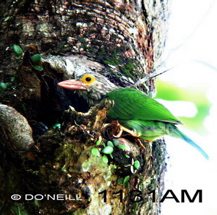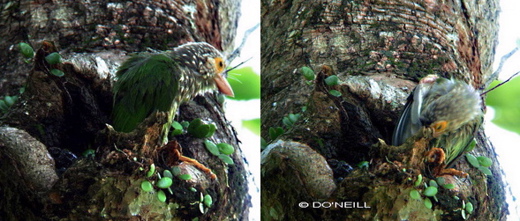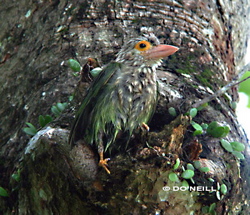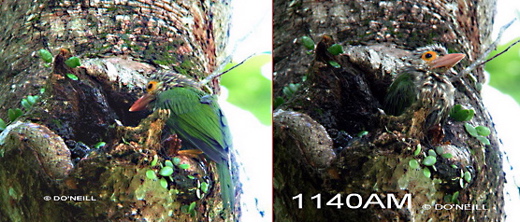In the northern Yamanouchi prefecture of Japan, Japanese macaques are known to winter dip in hot springs near Nagano. They were first discovered in the 1960’s and soon these species of macaques (Macaca fuscata) became famously known as the ‘Japanese Snow Monkeys’.
During ancient Roman times, Roman baths were built to placate the pleasures of Roman lifestyle. The evidence in archaeological digs discovered in Europe to lands end wherever Roman conquests were reached can still be seen today.
Soaking oneself in hot springs and baths is luxuriously soothing and therapeutic to one’s mind and body. It leaves a person feeling relaxed and in a state of euphoria.
Perhaps… the Japanese Snow Monkeys too felt no exception judging from their mood and expression on their faces, as they soaked in those healing, mineral hot springs ignoring the free fall of snow flakes from the wintery skies.
Do birds indulge in this art of bathing?
Several species of barbets seemed to have generously given me special privileges to share some of their private moments in their everyday lives. They have allowed me to observe them at close quarters.
Here in a tropical, warm forest of Malaysia, is our unbashful feathered friend, Lucinko, the Lineated Barbet (Megalaima lineata) demonstrating a birding bath that took 9 mins.
Lucinko was seen flying onto a perch of an old stump of a tree branch about 15 feet off the ground. It had rained heavily the night before and a pool of rain water had accumulated overnight in a deep, hollow cavity at the fork of the old tree stump.
She proceeded to inspect her new found bathing spot for approval.
“This tree spa sure looks good!” exclaimed Lucinko (above).
With delight and with no hesitation, she slipped in modestly for a dip and a good soak. Her plumage was green like the colour of imperial jade and her head feathers looked like she had white hair nettings to her dark brown feathered head (right).
When Lucinko turned round and saw me ‘capturing’ her on a frontal shot, she moved further back to partially conceal her modesty. Her upper and lower pink bills peaked like Mt. Fujiyama and her dark brown eyes like buttons, sparkled with delight (below).
This episode of Lucinko’s bathing reminded me of my first amusing encounter in a ‘Minshuku’ – a Japanese home stay, government regulated programme in the 1980’s, where I first visited while pursuing the interests of Japanese lifestyle, culture and their arts.
I was shown the family bathroom. It was pretty sparse and a large, squarish, stainless steel, aluminium kind of opened top tank and filled with warm water. It was staring at me. The size of the metallic bathtub was large enough to drown a 5 year old child in it but a fat scuba diver would definitely be stuck, breaking the law of water displacement and flooding the minshuku.
One reads of the common practice of bathing in a Japanese bathtub.
Here I was globetrotting and finally starring at one. In one corner of the small bathroom, a low and lonely, wooden stool stood waiting my service. The Mamasan-lady of the house was explicit that I do not get into the bathtub.
I had to solve a Japanese bath riddle.
How do a non-Japanese, two legged bird take a Japanese bath with just two basic Japanese elements in a Japanese home in the ancient city of Kyoto in April?
A lot of creativity needed. It might be refreshing for readers to imagine oneself in such a situation and have a hilarious laugh over it.
“Brr…it’s getting cold” shuddered the bird and decided to crawl out of the cavity. Drenched, she proceeded to clean her armpits, preened her rear feathers and gave a hearty wriggly shake (above and below).
Lucinko then stepped out of her cool spring, revealing her yellow feet matching with her yellow orbital eye skin (below).
This scenario reminded me of the 1960’s Chinese blockbuster, epic movie, ‘Empress Wu Ti Xian’.
The story line tells of a favourite concubine of a Chinese Emperor who eventually brought the country to grief by the Emperor’s negligence of court duties in hot pursuit of his insatiable indulgence in her beauty.
The bathing scene of the Empress was the favourite and famous scene which drew ‘full-house’ in Hong Kong’s Shaw Brothers (the equivalent of MGM in the west) movie cinemas throughout Malaysia.
The scene opened with the Empress being prepared for a spa bath. It was revealing enough to get the audience to sit up peering and peering through a semi-transparent white silk curtain.
The Emperor eventually showed up and the seductive Empress knowingly requested ‘His Highness’ to approach her with her bath robe.
“Kor lai…..” (Come here)…….murmured the Empress.
The Chinese Emperor was seen trembling and drooling in the weakness of his flesh. He collapsed onto his knees as though awaiting to receive a Goddess and swooned in sheer excitement of what was to take his breath away. The audience too were equally swooned upon hearing such a seductive call and eagerly awaiting the revelation of the Empress’s beauty so renowned – the role played out by the then famous actress-Li Li Hwa.
This lady bird is but of a different kind!
Lo and behold, the projectionist suddenly switched everything off leaving the cinema and audience in darkness. The sporting audience responded with cat calls, whistling – “Phee.. Phew!” I could still remember the anti-climatic shouts and ecstatic screams the audience gave out and some even resorted to banging their collapsible theatre chairs to say, “More! More!”
To console readers, I am no projectionist but an amateur writer to amuse you with a bit of my interesting life adventures, apart from bringing you back to earth with real images of a bathing bird through my digiscope and taken with consent.
The image above shows Lucinko drying out in the morning sun. She turned around to sun dry her rear then finally her front (below)
Finally at 11.40 am, the Jade Empress having had a satisfying and peaceful bird bath, bade me farewell, flew and vanished.
I bade farewell too. I did not collapse nor did DG Scope.
DAISY O’NEILL, AVIAN WRITER, PENANG, MALAYSIA.

















One Response
Sounds like you had great fun, Daisy, both watching the barbet and writing up your story. Thanks for the link.